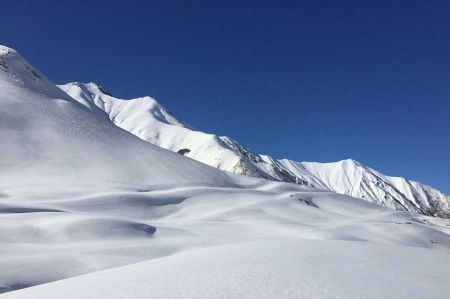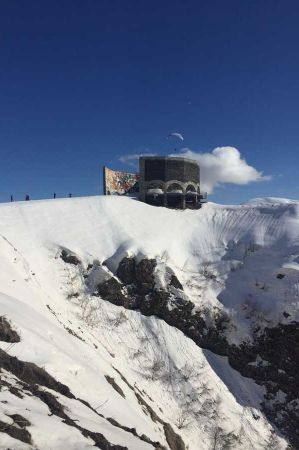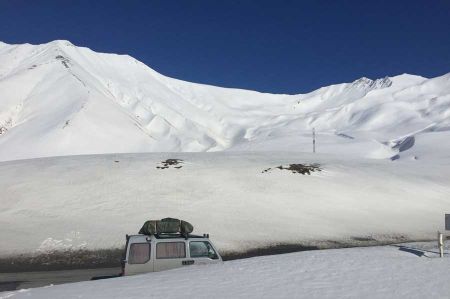Georgian Army Road - the border crossing to Russia
- Written by Portal Editor
Back from the attempt to cross the Greater Caucasus on the Georgian Highway in the direction to Russia, Micha and Philipp told us about their experiences along the high mountain road, which leads up to 2,382 meters altitude.
Not just the season with a lot of snow and great cold has caused a great deal of trouble for the two travelers. Above all, it was the disappointment of the dismissive Russian border inspectors who stopped their onward journey so much abruptly.
Although equipped with a business travel visa of a travel agency known for its reliability, the two were still denied enter to Russia. What exactly prevented the entry, is, after the statements of the border guards still somewhat unclear, difficult-to-understand, it could also have been the currently re-enforced sanctions against Russia. However, the further research also revealed that instead of a business visa it could have been possible to obtain a visa based on cultural exchange. Anyway, there are new plans now.
A highway that was already used by the Greeks and Romans
 The Georgian Army Highway is the still used historical name of a highway in the Greater Caucasus that traverses the mountains between Russia and Georgia over 213 kilometers. It has played an important strategic role in the development of the Transcaucasian relations of the riparian states to this day. The army road follows a route that has been used by soldiers and traders for millennia. The Greek geographer Strabon described it in the first century.
The Georgian Army Highway is the still used historical name of a highway in the Greater Caucasus that traverses the mountains between Russia and Georgia over 213 kilometers. It has played an important strategic role in the development of the Transcaucasian relations of the riparian states to this day. The army road follows a route that has been used by soldiers and traders for millennia. The Greek geographer Strabon described it in the first century.
The route was initially unpaved and was then also called route crossing the Dariel Pass. The Russian army built it to a real paved street during the 5th Russian War against the Turks (1768 to 1774) for the transport of their troops. Under the command of General Gottlob Heinrich von Tottleben, the way was widened, tracks in the mountains were made and bridges built.
Russian-Turkish War provides expansion of the route
 In 1799, the expanded Georgian Army Road was handed over to the public. In 1827 General Alexei Yermolov campaigned against Chechens who repeatedly robbed travelers on the route. Subsequently, the Russian administration secured the army road with Cossacks. Small residential and guardhouse were built at regular intervals on the street.
In 1799, the expanded Georgian Army Road was handed over to the public. In 1827 General Alexei Yermolov campaigned against Chechens who repeatedly robbed travelers on the route. Subsequently, the Russian administration secured the army road with Cossacks. Small residential and guardhouse were built at regular intervals on the street.
Until 1863 the road surface was improved. Official post coaches daily drove the army road in both directions. The wagons were pulled by six to eight horses, the animals were exchanged at different stations. From 1900, cars gradually took over the function of the carriages.
During the Second World War, the Wehrmacht's 1st Panzer Army tried to block the road in the fall of 1942 because it was used to supply the Soviet troops north of the Caucasus with equipment and even to advance southwards towards Georgia. However, the attack got stuck in December 1942 at Vladikavkaz, without being able to reach the road.
Places & stations at Georgian Army Road
The Georgian Army Road connects Vladikavkaz in the Russian North Ossetia-Alania with Tbilisi in Georgia. The road leads from Vladikavkaz through the Terek valley crossing the Russian-Georgian border through the Dariel Canyon (also called Dariel Pass), through the town of Stepanzminda and southeast past the mountain Kasbek. At the village of Almassiani, the road turns into the ravine of the right Terek tributary Baidarka. At its southern end, it overcomes the main crest of the Greater Caucasus on the cross pass called Mtiuleti ridge on this section. The road continues past the former post office Gudauri (2196 m) and in serpentines down to the White Valley or Mtiuleti-Aragwi. It follows the river until its union with the Black or Gudamaqri-Aragwi to the Aragwi at Passanauri, and then it continues to its confluence with the Kura at Mtskheta, not far from Tbilisi.
In higher areas of the army road there is lot of snow until the end of May, what Micha and Philipp can just confirm. In late autumn and winter, there are often heavy snowfalls and avalanches. The road becomes impassable then. Some more reports about Georgia will follow.
Please read as well:
Back from Georgia - Bread with Turkisk sucuk and jalapeno
From Camping Rino to Struga - bike route well usable
-
 From Tiflis to Georgian Military Road
From Tiflis to Georgian Military Road
From Tiflis to Georgian Military Road
From Tiflis to Georgian Military Road
-
 From Tiflis to Georgian Military Road
From Tiflis to Georgian Military Road
From Tiflis to Georgian Military Road
From Tiflis to Georgian Military Road
-
 From Tiflis to Georgian Military Road
From Tiflis to Georgian Military Road
From Tiflis to Georgian Military Road
From Tiflis to Georgian Military Road
-
 From Tiflis to Georgian Military Road
From Tiflis to Georgian Military Road
From Tiflis to Georgian Military Road
From Tiflis to Georgian Military Road
-
 From Tiflis to Georgian Military Road
From Tiflis to Georgian Military Road
From Tiflis to Georgian Military Road
From Tiflis to Georgian Military Road
-
 From Tiflis to Georgian Military Road
From Tiflis to Georgian Military Road
From Tiflis to Georgian Military Road
From Tiflis to Georgian Military Road
-
 From Tiflis to Georgian Military Road
From Tiflis to Georgian Military Road
From Tiflis to Georgian Military Road
From Tiflis to Georgian Military Road
-
 From Tiflis to Georgian Military Road
From Tiflis to Georgian Military Road
From Tiflis to Georgian Military Road
From Tiflis to Georgian Military Road
-
 From Tiflis to Georgian Military Road
From Tiflis to Georgian Military Road
From Tiflis to Georgian Military Road
From Tiflis to Georgian Military Road
-
 From Tiflis to Georgian Military Road
From Tiflis to Georgian Military Road
From Tiflis to Georgian Military Road
From Tiflis to Georgian Military Road
-
 From Tiflis to Georgian Military Road
From Tiflis to Georgian Military Road
From Tiflis to Georgian Military Road
From Tiflis to Georgian Military Road
-
 From Tiflis to Georgian Military Road
From Tiflis to Georgian Military Road
From Tiflis to Georgian Military Road
From Tiflis to Georgian Military Road
https://www.alaturka.info/en/roman-road-project/4417-georgian-army-road-the-border-crossing-to-russia#sigProId1170c00220

